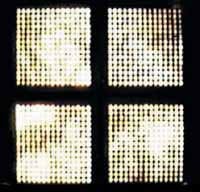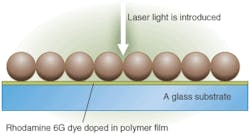Newsbreaks
Silicon microdischarge arrays live longer
Silicon microdischarge devices have inverted pyramidal cathodes that cause a gas such as neon (Ne) to emit light (see Laser Focus World, September 2000, p. 32). The devices have been made into very small arrays with lifetimes of a few minutes; the goal is to fabricate long-life arrays large enough to be used as flat-panel displays. The group at the University of Illinois at Urbana-Champaign and Ewing Technology Associates (Bellevue, WA) that invented these devices is making steady progress on both lifetime and array size.
One improvement is the replacement of the earlier single-layer polymer dielectric with a multilayer dielectric of silicon dioxide, silicon nitride, and polymer. The resulting device, which can be operated without external ballast, operates at a voltage as low as 133 V at a Ne gas pressure of 900 torr. Lifetimes increased by more than an order of magnitude to 2 h. Here, four 15 x 15 arrays of 50 x 50-µm devices with 50-µm separation operate at 271 V in 400 torr of Ne. The use of screen electrodes and molecular emitting gases will dramatically increase efficiency, say the researchers. Contact Gary Eden at [email protected].
Aluminum pushes gallium nitride-based emitters to the deep ultraviolet
Gallium nitride (GaN)-based light-emitting diodes and lasers typically rely on the addition of indium (In) to determine their wavelength; the less indium included, the shorter the wavelength is, with 360 nm the shortest possible. Lowering the wavelength further requires the addition of aluminum (Al). Scientists at the Institute of Chemical and Physical Research (Saitama, Japan), Waseda University (Tokyo, Japan) and the Tokyo Institute of Technology (Yokohama, Japan) have now demonstrated efficient photoluminescence (PL) of multiple AlGaN-based quantum wells, with the emission wavelength ranging from 232 to 284 nm.
Efficient single-peak PL emission was obtained at 77 K, with the wavelength adjusted from long to short by changing the Al content of the AlxGa1-xN barriers from 53% to 100%. Samples were excited with a 215-nm-emitting xenon light source. The highest efficiency occurred for a barrier Al content of 80%, corresponding to a 245-nm emission wavelength. The efficiency was as high as that of blue-emitting InGaN-based quantum wells at 77 K. Efficiency of the short-wavelength devices will be further raised by the addition of GaN into the AlN buffer, improving crystal quality. Contact Hideki Hirayama at [email protected].
Winners of Young Investigator Award announced at Photonics West 2002
The recipients of this year's Young Investigator Award were announced at Photonics West 2002 (San Jose, CA) in January. The award, presented annually in memory of Heather Williamson Messenger, former executive editor of Laser Focus World, is for the best paper by a young researcher or researchers graduated within five years of the conference. The winners were Alexander S. Kuzhelev, Alexander Dudelzak, and Pierre-Paul Proulx of the Canadian Space Agency (Saint-Hubert, Que., Canada); William E. Douglas of the Université Montpellier II (Montpellier, France); and Larissa G. Klapshina and Tatyana I. Lopatina of the Institute of Metallo-Organic Chemistry, Russian Academy of Sciences (Moscow, Russia) for their paper, "New Photorefractive Polymer Composites Highly Sensitive at 1500 nm." Previous photorefractive polymers were efficient only in the visible range; the researchers developed a version efficient at 1500 nm, a wavelength favorable for optical information-processing applications. Contact William Douglas at [email protected].
Gallium selenide emits coherent terahertz radiation
In a development that will further stimulate the already expanding fields of terahertz imaging and spectroscopy, researchers at the University of Arkansas (Fayetteville, AR), Shandong University (Jinan, China), the Air Force Research Laboratory (Wright-Patterson AFB, OH), and Blue Leaf Networks (Sunnyvale, CA) have developed a compact, powerful, tunable, coherent terahertz source based on a new materialgallium selenide (GaSe). At 196 µm (1.53 THz), the optically pumped device emits pulses of up to 69.4 W peak output, corresponding to a photon conversion efficiency of 3.3%. The researchers attribute this high value to a large second-order nonlinearity in GaSe, as well as the substance's extremely low absorption in the terahertz region.
A nanosecond-pulsed Nd:YAG laser and an Nd:YAG-pumped optical parametric oscillator pump the GaSe crystal, with the maximum peak intensity in the crystal remaining an order of magnitude below the damage threshold. The generated terahertz waves are focused by off-axis metal mirrors, and can be tuned from 0.18 to 5.27 THz. The 15-mm-thick crystal emitted 5-ns pulses at a 10-Hz repetition rate. Gallium selenide crystals of other thicknesses had slightly different tuning ranges. Contact Yujie Ding at [email protected].
Porous liquid-crystal and silicon mirror is electrically tunable
Sharon Weiss and Phillipe Fauchet of the University of Rochester (Rochester, NY) have developed a silicon-based mirror that has an electrically tunable 2-nm resonance, and thus a tunable reflectivity. Early experiments verify this effect, and simulations show the device can potentially have a reflectivity adjustable between 0% and 100%. The device is based on liquid-crystal molecules infiltrated into porous silicon (Si), forming a multilayer structure. The results were presented at Photonics West 2002 (San Jose, CA) in January.
A Si structure is fabricated that consists of alternating low- and high-porosity layers. The layers are created by electrochemically etching the Si in a solution of hydrofluoric acid and periodically varying the current density. Layers that are 165 nm thick of 50% porosity alternating with 190-nm layers of 70% porosity can be created. A defect layer is included to form a microcavity. Liquid-crystal material is then infiltrated into the structure under vacuum by capillary forces. The mirror can be tuned either by electrical modulation or by heating. The tuning effect has been qualitatively observed in experiments; quantitative results are forthcoming. Contact Sharon Weiss at [email protected].
Microsphere waveguide channels light via resonance
Researchers at the National Institute of Advanced Industrial Science and Technology (Ibaraki, Japan) have demonstrated light propagation in a new type of waveguide similar to but distinct from a photonic-crystal waveguide. Consisting of dielectric microspheres in a hexagonal periodic array, the waveguide propagates light via resonance frequencies instead of bandgap frequencies.
Rhodamine 6G dye doped in polymer film was coated onto a glass substrate at a 100-nm thickness to excite the resonance mode in the microcavities. Polystyrene-latex spheres of a uniform 15.6-µm size immersed in water were then self-arrayed on the glass by coating the glass with the solution and letting the water evaporate. The 532-nm second harmonic of an Nd:YVO4 (vanadate) laser was introduced perpendicular to the substrate, exciting the dye. Discrete frequencies of the fluorescence satisfied the phase-matching condition, causing propagation. When the laser is focused at a contact point between two microspheres, the light propagates in one direction. Although propagation losses were high, limiting application to short distances, the technique avoids the necessity of defects as in photonic-crystal waveguides. Contact Hiromitsu Furukawa at [email protected].


